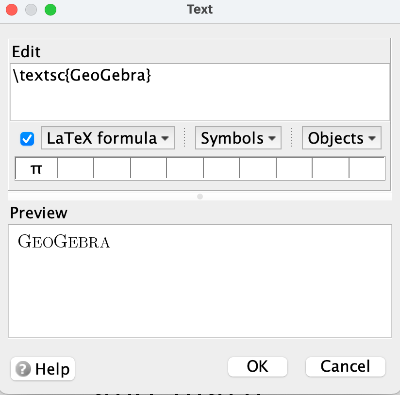Fonts
1. Font size
The size of the fonts can be changed globally with the following commands:
The command \normalsize back font to its original size. If you want to combine different font sizes should add the commands in braces {...}. This is an example of combination of sizes in math mode.
Example 1:
 The following is an example of combination of sizes in text/math mode using \oldstylenums{ ...} command (only math mode).
Example 2:
The following is an example of combination of sizes in text/math mode using \oldstylenums{ ...} command (only math mode).
Example 2:
 We can also use the command in text/math mode:
We can also use the command in text/math mode:
| \tiny | \scriptsize | \footnotesize | \small | \normalsize |
| \large | \Large | \LARGE | \huge | \Huge |
{\scriptsize A}{\footnotesize B}{\small C}{\normalsize D}{\large E}{\Large F}{\LARGE G}{\huge H}{\Huge I}
\text{{\Huge GeoGebra}, the most powerful, {\small since }}\oldstylenums{ 2001-2012}
\scalebox{h_scale}[v_scale]{...} where {h_scale} is a positive(negative) number (mandatory) and [v_scale] is a positive number (optional), numbers can be sliders.
Example 3:
\scalebox{2}{\text{{\Huge GeoGebra}, the most powerful, {\small since }}\oldstylenums{ 2001-2012}}
2. Font Family
In text mode we have the following families of text, we can use globally or using braces {...}:
 In math mode we have the following families (default mathrm):
In math mode we have the following families (default mathrm):
Example 2:

\rm or {\rm } \sf or {\sf } \tt or {\tt }
Example 1:
\text{{\rm GeoGebra}{\sf ,the most powerful}, {\tt since }}\oldstylenums{ 2001-2012}
 In math mode we have the following families (default mathrm):
In math mode we have the following families (default mathrm):
| \mathcal{ABC} | \mathrm{abc} | \mathbf{abc} | \mathsf{abc} | \mathit{abc} |
| \mathtt{abc} | \mathfrak{abc} | \mathbb{ABC} | \mathscr{ABC} |
\mathbb{G}\mathfrak{e}\mathbf{o}\mathsf{G}\mathscr{E}\mathtt{b}\mathit{r}\mathrm{a}

4. Font Shapes
For Small Caps in text mode use:
\text{{\sc GeoGebra}
or
\textsc{GeoGebra}

